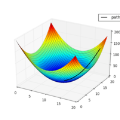Data-driven offline model-based optimization (MBO) is an established practical approach to black-box computational design problems for which the true objective function is unknown and expensive to query. However, the standard approach which optimizes designs against a learned proxy model of the ground truth objective can suffer from distributional shift. Specifically, in high-dimensional design spaces where valid designs lie on a narrow manifold, the standard approach is susceptible to producing out-of-distribution, invalid designs that "fool" the learned proxy model into outputting a high value. Using an ensemble rather than a single model as the learned proxy can help mitigate distribution shift, but naive formulations for combining gradient information from the ensemble, such as minimum or mean gradient, are still suboptimal and often hampered by non-convergent behavior. In this work, we explore alternate approaches for combining gradient information from the ensemble that are robust to distribution shift without compromising optimality of the produced designs. More specifically, we explore two functions, formulated as convex optimization problems, for combining gradient information: multiple gradient descent algorithm (MGDA) and conflict-averse gradient descent (CAGrad). We evaluate these algorithms on a diverse set of five computational design tasks. We compare performance of ensemble MBO with MGDA and ensemble MBO with CAGrad with three naive baseline algorithms: (a) standard single-model MBO, (b) ensemble MBO with mean gradient, and (c) ensemble MBO with minimum gradient. Our results suggest that MGDA and CAGrad strike a desirable balance between conservatism and optimality and can help robustify data-driven offline MBO without compromising optimality of designs.
翻译:数据驱动的离线基于模型的优化(MBO)是一种已经建立的黑盒计算设计问题的实用方法,其中真实的目标函数是未知的且查询成本高昂。然而,优化针对学习到的真实目标的代理模型的设计的标准方法可能会遭受分布偏移的影响。特别是在高维设计空间中,其中有效的设计位于狭窄的流形上,标准方法容易产生越界的非法设计,这些设计“欺骗”了学习的代理模型输出高值。使用集合而不是单个模型作为学习的代理可以有助于减轻分布漂移,但是合并来自集合的梯度信息的幼稚公式,例如最小或平均梯度,仍然是次优的,并且经常受到非收敛行为的阻碍。在这项工作中,我们探讨了替代方法来合并来自集合的梯度信息,这些方法对于分布漂移具有鲁棒性,而又不会损害所生成的设计的最优性。具体来说,我们探讨了两个函数,它们被明确为凸优化问题,用于组合梯度信息:多梯度下降算法(MGDA)和冲突回避梯度下降(CAGrad)。我们对五个不同的计算设计任务进行了这些算法的评估。我们将集合MBO与MGDA和集合MBO与CAGrad的性能与三个幼稚的基线算法进行了比较:(a)标准单模型MBO,(b)集合MBO与平均梯度和(c)集合MBO与最小梯度。我们的结果表明,MGDA和CAGrad在谨慎性和最优性之间达到了令人满意的平衡,并且可以帮助使数据驱动的离线MBO具有鲁棒性,而不会损害设计的最优性。



